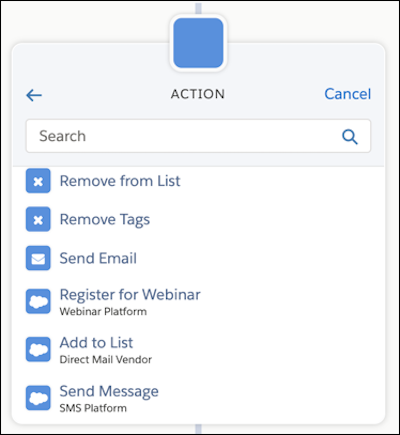Automate Actions in Third-Party Apps
Learning Objectives
After completing this unit, you’ll be able to:
- Describe what external actions are.
- Identify three ways to build an external action.
Supercharge Engagement Studio Programs
In the last two units, you read about the marketer’s dilemma and how to bring third-party data into your Account Engagement automations. You appreciate the power of connecting data across platforms, but what if you could do even more? The tool we’re about to introduce takes that power to the third party. Let’s talk about External Actions.
What Are External Actions?
An external action is a way to initiate a task in a third-party application. Like an external activity type, it’s represented as a record that’s related to a marketing app extension.
External Actions rely on Salesforce’s invocable actions framework, so you can choose from standard, prebuilt actions or create a custom action that meets your business needs.

Some examples of an external action include:
- Registering a customer for a webinar or in-person event
- Triggering an SMS or direct mail send
- Storing new data in a third-party system, such as an email address or preference
- Creating a record in Salesforce, such as a task in Sales Cloud
How Do External Actions Work?
An external action uses a Salesforce invocable action to call a third-party system and securely pass information that then triggers a task in that system.
Some standard invocable actions are supported for external actions. If those don’t meet your use case, you can install an action from the AppExchange or build your own invocable action with APEX, Flow Builder, or External Services.
The creation method you choose depends on your experience with APIs, certain types of code, and whether you’re calling out to another Salesforce cloud or a completely separate application. Flow Builder is ideal for triggering actions inside the Salesforce ecosystem. If you’re calling a third-party app and have tons of APEX knowledge, then that’s the solution for you. And if you need to connect a third-party app but you prefer a declarative, no-code option, try External Services. Let’s take a look at the steps needed to configure and use an external action. More details about each step can be found in Salesforce Help and the External Actions Developer Guide.
- Choose, install, or build an invocable action.
- Create the external action record in Marketing Setup.
- If you're using a standard invocable action or customizing your own, edit the schema to fit your use case.
- Activate the external action.
- Add the external action to an Engagement Studio program.
Put External Actions to Use
After you configure an external action, multiply its power with marketing automation. Use Engagement Studio to replicate the task with any prospect who meets the necessary criteria, without manual intervention.
Let’s go back to our Northern Trail Outfitter example where the customer Rachel submitted a marketing form to sign up for a physical mailing list, and later received a postcard in the mail. How did it work? Remember that Paulo and Warren created a marketing form, configured an external action called Add to List, and then added steps to an Engagement Studio program.
First, the engagement program listens for the form submission and sends the associated prospect to the next step. Then, the Add to List external action grabs Rachel’s mailing address from her record and passes it to NTO’s mailing house vendor system, which adds her address to the next mailing.
And because Paulo added the external action to an engagement program, the same process occurs every time a prospect submits the linked form.
After the technical work is done, marketing users can add external actions to an engagement program. When you’ve thought through where the action should go in the program, create a step and select the Action type.

Scroll or search for an external action you want to use, and check the extension label to confirm it’s the one you want. Select it, and then tell Engagement Studio whether you want the action to occur immediately or to wait. That’s it!
Guidelines for External Actions
For best results, you’ll need both an admin and a developer to create or install an invocable action and make it usable in Account Engagement. To get started using the invocable actions framework, make sure you check out Salesforce Help and Developer Guides that provide critical details about how to configure your best solution.
External Actions is a powerful extensibility tool that you can use to bring data and marketing tasks together. Admins and developers, work together and find some tasks to supercharge.
Resources
- Salesforce Help: Execute External Actions on Prospects
- Salesforce Help: Supported Standard Invocable Actions
- Developer Guide: Create and Configure External Actions via API